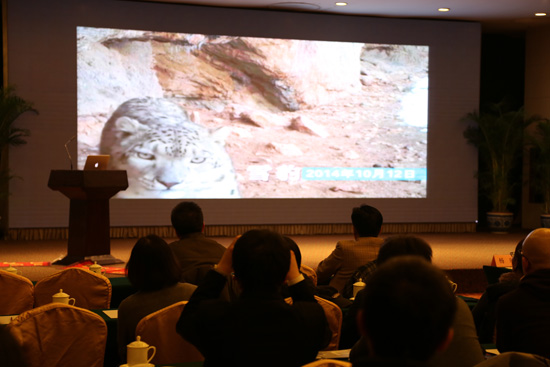Rare wildlife found in Qinghai-Tibetan canyon
- By Zhang Rui
 0 Comment(s)
0 Comment(s) Print
Print E-mail China.org.cn, January 16, 2015
E-mail China.org.cn, January 16, 2015
An ecological research team said in Beijing on Wednesday that they found many rare animals and plants in Yanzhanggua Canyon on the Qinghai-Tibetan Plateau during their 10-month observation of the area.
|
A photo of a snow leopard found by the 2014 expedition in Yanzhanggua Canyon on the Qinghai-Tibetan Plateau of China is shown at a Beijing press conference on the wildlife of Yanzhanggua Canyon on Jan. 14, 2015. [China.org.cn] |
The research, initiated by China Environmental Protection Foundation and the local government of Yushu Tibetan Autonomous Prefecture, was carried out by the environmental protection non-governmental organization Greenriver and was completed in December 2014.
The team said that they found between nine and 14 snow leopards, 50 to 80 white-lipped deer, 10 Alpine musk deer, 20 wild yaks, 10 kiangs, as well as Tibetan antelopes, brown bears, wolves, lynxes, bharals, red foxes and more in a 40-square-kilometer area after they installed 39 infrared cameras along the 10-kilometer-long canyon. They also found 200 kinds of plants including Aster souliei and Incarvillea compacta.
Scientists established a base at the Yangtze River Headwaters Ecological Conservation Station and surveyed the biological diversity of the Yangtze River's biggest canyon.
Their report said the unique landscape and ecological environment features abundant grass and plants that can feed a large number of herbivorous animals. However, the planned construction of a new hydroelectric power station in the eastern section of the canyon will destroy the environment and break wildlife's food chain if the project begins.
Li Wei, secretary-general of China Environmental Protection Foundation, said at the Beijing press conference that protecting Qinghai's ecological environment is of great significance in the nation's ecology security strategy.'It is not just a responsibility for Qinghai Province, but also a responsibility for society. A civilized society with a great natural ecology will help Chinese people realize the dream of revival and will benefit future generations and sustainable development.'
Experts from the Ministry of Environmental Protection, the Chinese Academy of Sciences, the Chinese Research Academy of Environmental Sciences, Qinghai Environment Monitoring Center, the Institute of China Academy of Traditional Chinese Medicine, the World Conservation Union, The Nature Conservancy, Peking University, Sichuan University, Nanjing Agricultural University and Greenriver jointly signed a statement asserting that this area is in the core of the Sanjiangyuan National Nature Reserve. The statement also demanded further and strengthened monitoring and scientific research in this area in addition to calling for an end to exploitative commercial activities that will affect this area's ecosystem.
A total of 67 volunteer zoologists, botanists, anthropologists, electrical engineers, photographers, doctors, explorers, rock climbers, drivers, and logistics workers have joined hands in this research program since April 2014. Their journey on foot and by motor vehicles totaled 50,000 kilometers.
The experts summoned by the Ministry of Environmental Protection reviewed and approved the team's expedition and their report. The authorities then urged China Environmental Protection Foundation to expand the strength and depth of the research in the canyon for one more year.







Go to Forum >>0 Comment(s)